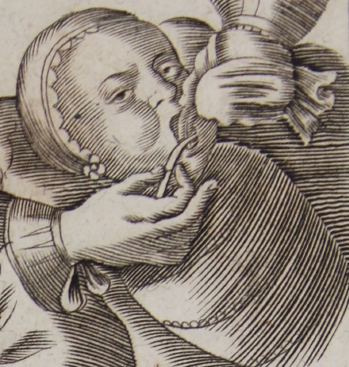Tongue ties are being blamed on social media for a slew of woes affecting infants—from nipple pain to poor napping to speech issues—but many experts agree that the rise in diagnosis and treatment is being led by consumer demand rather than by hard science.
Explore This Issue
September 2019Tongue tie, or ankyloglossia (AG), is a congenital condition in which an abnormally short frenulum restricts the tongue’s ability to function properly. A lip tie is an unusually tight labial frenulum, which keeps the upper lip tethered to the gum line. Tongue and lip ties often occur in tandem, are more common in boys than girls, and tend to run in families.

Wood block of a physician performing a frenectomy, dated 1679.
© Wood block courtesy of Dr. Messner
The diagnosis and treatment of AG is not new, said Anna Messner, MD, a professor at Baylor College of Medicine and division chief of otolaryngology/head and neck surgery at Texas Children’s Hospital in Houston. “There are wood cuts showing a physician cutting a newborn’s frenulum dating back to 1679” (right). However, the treatment became less common as women turned away from breastfeeding in favor of formula and bottle feeding around the middle of the last century. In the last quarter century, the pendulum has swung back in favor of breastfeeding and, with that, an increase in the number of women seeking help with nursing issues.
“For many women, breastfeeding can be extremely painful for the first few weeks,” Dr. Messner said. Successful breastfeeding requires proper technique, in which the tip of the nipple hits the roof of the mouth and creates a vacuum on the breast. This differs from compressing the nipple, which effectively squeezes the milk out rather than sucking. “The tongue is a powerful muscle, but it can’t suck and draw milk out of the breast if it’s not fully underneath the nipple,” said Julie Wei, MD, division chief of otolaryngology in the department of surgery at Nemours Children’s Health System in Orlando, Fla.
In some infants with limited tongue mobility, AG is associated with significant breastfeeding issues—including painful nipples, damaged nipples, poor milk transfer, low milk supply, early cessation of breastfeeding, and failure to thrive (JAMA Otolaryngol Head Neck Surg. 2017;143:1032–1039). “With all the health benefits associated with breastfeeding, this issue [of AG] has become more important to mothers,” said Karthik Balakrishnan, MD, MPH, associate professor in the division of pediatric otolaryngology at the Mayo Clinic in Rochester, Minn. “Social media both facilitates and exacerbates the concerns of mothers and has been a big driver in the increase in diagnosis and treatment of AG,” he added. This has led mothers to seek help from lactation consultants in the first weeks of breastfeeding. Lactation consultants often then recommend a referral for tongue tie diagnosis and treatment (BMC Pregnancy Childbirth. 2017;17:373).
Considerable controversy surrounds this condition, however. Otolaryngologists, oral surgeons, pediatricians, speech therapists, and lactation consultants often have differing opinions regarding the definition, clinical significance, need for surgical intervention, and timing of treatment of ankyloglossia.